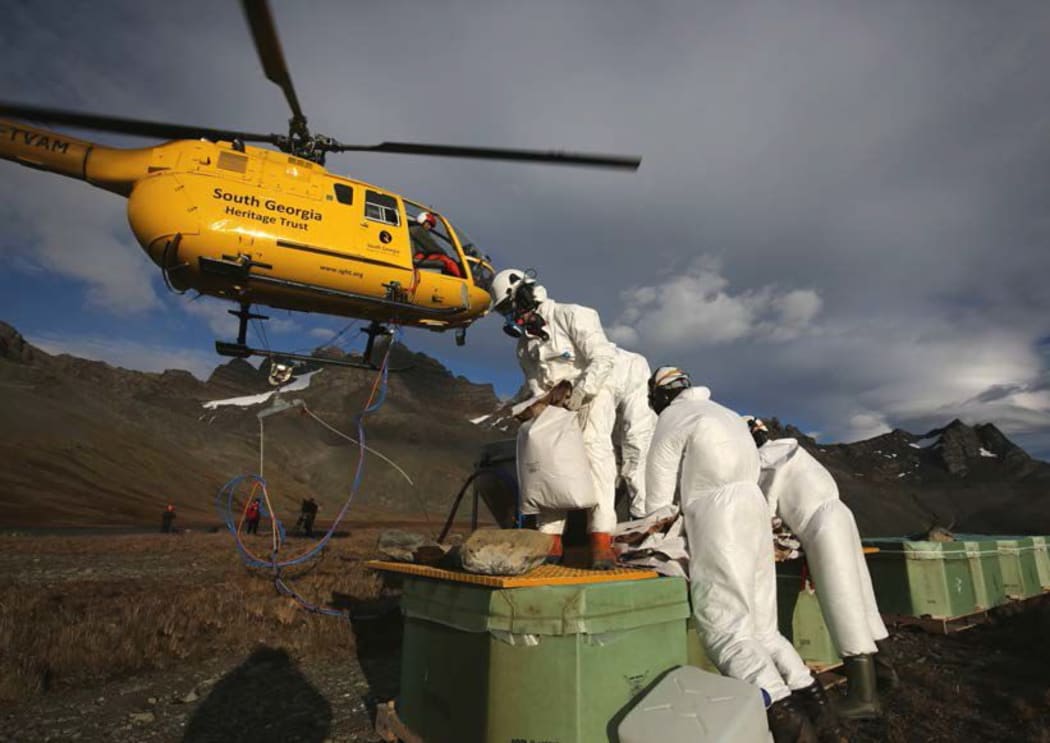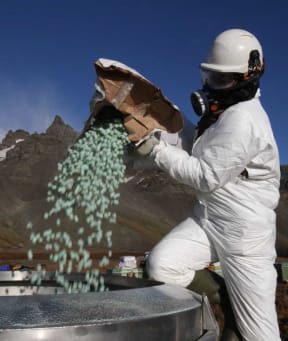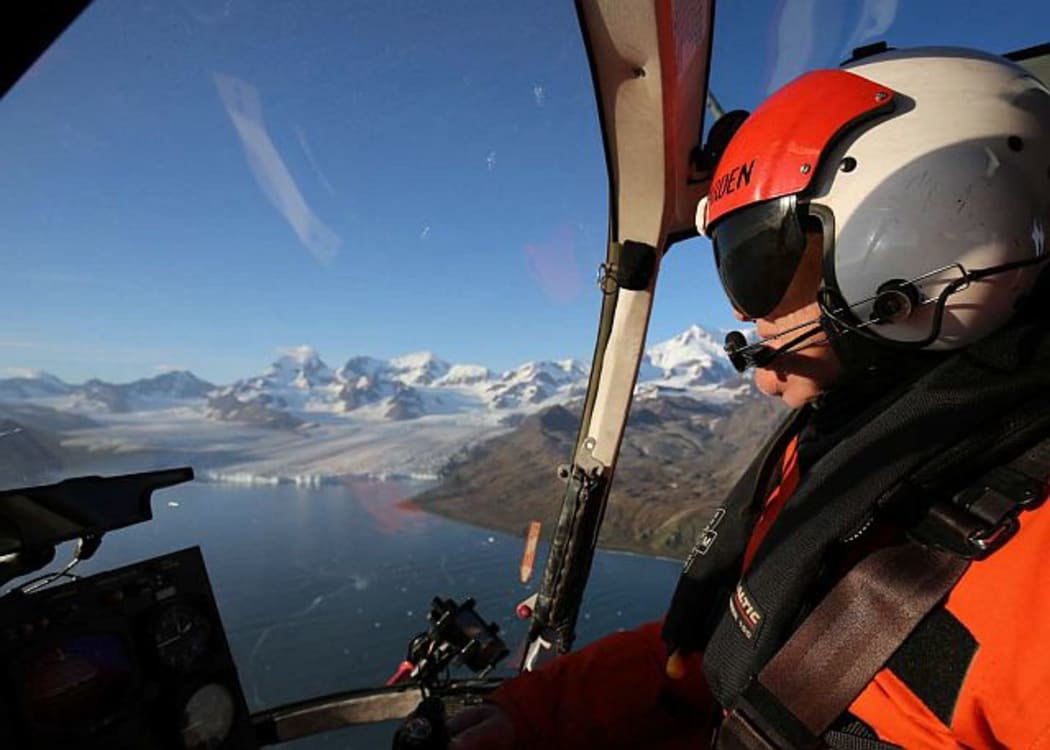By Alison Ballance
The world’s largest island rat eradication has just been completed, with the final load of rat bait dropped on subantarctic South Georgia Island from a helicopter flown by New Zealand pilot Peter Garden, using a specialised bait spreader developed and made in New Zealand. That the operation was possible at all was the result of 50 years of techniques and experience developed on New Zealand islands.

The very last bag of rat bait is loaded into the spreader bucket under Peter Garden’s helicopter Alpha Mike, at 12.37pm on 23rd March 2015 Photo: South Georgia Heritage Trust
The South Georgia rat eradication, which has been carried out by the South Georgia Heritage Trust’s ‘Heritage Restoration Project’, is nearly eight times larger than the previous largest island eradication on Australia’s Macquarie Island. University of Auckland biologist and eradication expert James Russell says it is globally significant.
“They didn’t just do an incremental change – they did a step change. They moved from 11,000 hectare Campbell Island and 13,000 hectare Macquarie Island, they just grabbed the bull by the horns and went for it.”
It all began in 1964, when the late Don Merton and fellow conservationists declared that they had got rid of Norway rats on tiny Maria Island, in the Hauraki Gulf. At that time just 0.5 per cent of New Zealand islands were free of mammalian pests; today, 10 per cent are pest-free. Following Maria Island, conservationists began to tackle larger and larger islands, such as 170 hectare Breaksea Island in Fiordland and then 2000 hectare Kapiti Island.

The rat eradication on South Georgia Island uses a bait containing an anticoagulant poison. Photo: South Georgia Heritage Trust
When Norway rats were eradicated from remote subantarctic 11,300 hectare Campbell Island in 2001, it was a monumental conservation achievement that suddenly opened up the possibility of restoring large islands around the world. The Campbell Island rat eradication, led by Peter McClelland, managed to overcome the obstacles of distance (700 km from mainland New Zealand) and ferocious subantarctic weather by using a team of five helicopters that used specialised bait-spreading buckets and GPS to spread baits containing the rodenticide Brodifacoum across the entire island, including the steep cliffs, ensuring that every rat on the island had access to the anticoagulant poison.
South Georgia Island is a British Territory that lies at 54°S, off the southern tip of South America, near the Falkland Islands. The island is 375,00 hectares in size. The area of the island from which rats had to be removed is 100,000 hectares in size, so large that the rat eradication had to take place in three stages over five years. The eradication has been a race against time, to get it completed before global warming melts the large glaciers that effectively divide the island into a number of ice-free valleys. Research into the genetics of rats living in different valleys, carried out by Bruce Robertson and Neil Gemmell from the University of Otago, confirmed that they were all distinct populations. This meant these ice-free areas could then be treated as ‘eradication units’, and this allowed the eradication to be done as a ‘rolling front’. Bait was dropped in a few eradication units in a trial carried out in 2011, a much larger number of units treated two years later, and the third and final bait drop treating the remaining ice-free valleys in February and March 2015.
The South Georgia Island rat eradication team leader, Tony Martin, reported in the late March issue of the Newsletter of the South Georgia Habitat Restoration Project, that Kiwi pilot Peter Garden, aided by two other New Zealand helicopter pilots, finished dropping the final bucket-load of bait on South Georgia just after midday on 23 March 2015.
Peter Garden has made significant contributions to many island eradications, beginning with Campbell Island. Eradication expert Peter McClelland says Peter Garden is highly respected.
“He’s certainly one of the top eradication pilots in the world. Both his flying skills, and also the work he puts in planning and preparing for these operations.”

Chief pilot Peter Garden flying on South Georgia Island, with Nordenskjöld Glacier in the background. Photo: South Georgia Heritage Trust
It will be two years before the valleys treated with bait this year can be checked to confirm whether or not the eradication has been a success, but there are signs that areas treated in 2011 are now rat-free, with the first confirmed nest of the threatened South Georgia pipit found in January 2015.
The next job of Team Rat, as they call themselves, is to head to the valleys treated in 2013, to see if any of the rat detection devices left there last summer give any indication of the presence of mice.
The idea of a rolling front was developed on Ulva Island in the 1990s and, according to James Russell, that technique is really important, “as it’s going to be the kind of approach that will be required to treat larger islands in future, and perhaps even scale up to a predator-free New Zealand.”
South Georgia Island is 170 kilometres long, between 2 and 40 kilometres wide, and rises to 2,934 metres at its highest. About three quarters of the island is covered in glaciers and snow fields, and apart from a brief snow-free summer period, it is usually covered in snow to sea level. At latitude 54°S, South Georgia is further south than New Zealand’s Campbell Island (52°S). The island is now uninhabited, about from two British Antarctic survey bases, but at the height of the whaling boom it was home to about 2000 people.
The South Georgia Habitat Restoration programme has been organised by the South Georgia Heritage Trust which raised more than £7.5 million.
The New Zealand Department of Conservation, meanwhile, is planning its next subantarctic island eradications. Eradication manager Stephen Horn says "the main Auckland Island (with mice, cats and pigs) and Antipodes Island (mice) are the only two island groups remaining in the New Zealand Subantarctic with introduced mammalian pest species."
"The Antipodes Island Mouse Eradication, planned for winter in 2016, is the next step towards a long term goal of a pest-free New Zealand subantarctic region," says Stephen. "The Antipodes project follows on from successes on Campbell Island - rats in 2001- and Enderby island - mice and rabbits in 1993 - with experience and expertise gained on these eradications helping to shape the strategy and identify the risks on Antipodes. The sites are of huge biodiversity value and a one-off eradication operation leaves a legacy of recovery and preservation for incredibly valuable ecosystems. The subantarctic region also has low risk of a return on mammalian pest species, so eradication is the single most effective conservation strategy for these situations."
Alison Ballance joined a Department of Conservation expedition to Antipodes Island in 2014, carrying out pre-eradication monitoring and fixing the island hut which was damaged by a slip early in 2014.

